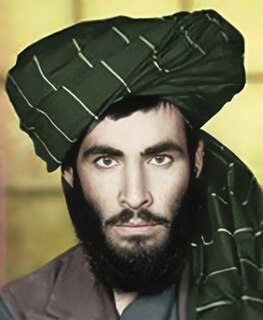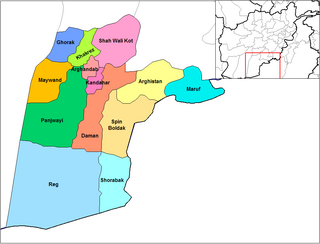
Kandahar is a city in Afghanistan, located in the south of the country on the Arghandab River, at an elevation of 1,010 m (3,310 ft). It is Afghanistan's second largest city after Kabul, with a population of about 614,118. It is the capital of Kandahar Province as well as the de facto capital of the Taliban, formally known as the Islamic Emirate of Afghanistan. It also happens to be the centre of the larger cultural region called Loy Kandahar. In 1709, Mirwais Hotak made the region an independent kingdom and turned Kandahar into the capital of the Hotak dynasty. In 1747, Ahmad Shah Durrani, founder of the Durrani dynasty, made Kandahar the capital of the Afghan Empire.
The Afghan Armed Forces were the military forces of the Islamic Republic of Afghanistan. While the armed forces de jure still exists, de facto it was effectively dissolved on 15 August 2021 after the fall of Kabul to the Taliban and the remnants of the military regrouping as the National Resistance Front of Afghanistan. They consisted of the Afghan National Army (ANA) and the Afghan Air Force. The President of the Islamic Republic of Afghanistan was the Commander-in-Chief of the Afghan Armed Forces, who were administratively controlled through the Ministry of Defense. Before the Fall of Kabul, they had major bases and small outposts all across Afghanistan, including in the provinces of Badakhshan, Balkh, Helmand, Herat, Kabul, Kandahar, Nangarhar and Parwan, as well as in the cities of Kunduz, Ghazni, Gardez, Khost, Fayzabad, Farah and Zaranj.

The Taliban is a Deobandi Islamist religious-political movement and military organization in Afghanistan. Currently one of two entities claiming to be the legitimate government of Afghanistan, alongside the internationally recognized Islamic Republic of Afghanistan, the Taliban maintain de facto control over the country. The Taliban's ideology has been described as combining an "innovative" form of Sharia Islamic law based on Deobandi fundamentalism and militant Islamism, combined with Pashtun social and cultural norms known as Pashtunwali, as most Taliban are Pashtun tribesmen. The group is internally funded by its activities in the illegal drug trade by producing and trafficking narcotics such as heroin, extortion, and kidnap and ransom. They also seized control of mining operations in the mid 2010s which were illegal under the previous government.

Mohammed Omar, was an Afghan mullah (cleric) and mujahid commander who led the Taliban and founded the Islamic Emirate of Afghanistan in 1996.

Panjwayi is a district in Kandahar Province, Afghanistan. It is widely considered the spiritual home of the Taliban and is located about 35 kilometres (22 mi) west of Kandahar. The district borders Helmand Province to the southwest, Maywand District to the west, Zharay District to the north, Arghandab, Kandahar and Daman districts to the east and Reg District to the south. The population was around 77,200 in 2006, most of which are peasants and poorly educated due to non-availability of schools. The district center is Bazar-e Panjwayi, located in the northern part of the district. The area is irrigated by the Helmand and Arghandab Valley Authority.
Canada's role in the Afghanistan War began in late 2001. Canada sent its first element of soldiers secretly in October 2001 from Joint Task Force 2, and the first contingents of regular Canadian troops arrived in Afghanistan in January–February 2002. Canada took on a larger role during the Afghan conflict starting in 2006 after the Canadian troops were redeployed to Kandahar province. 2,500 Canadian Forces (CF) personnel were in Afghanistan and 1,200 made up the combat battle group. At the 2012 NATO Summit in Chicago, Prime Minister Stephen Harper announced that an undisclosed number of Canadian soldiers would remain in the country to help train and mentor the Afghan National Army until 12 March 2014.

In late 2001, the United States, supported by its close allies, invaded Afghanistan and toppled the Taliban government. The invasion's public aims were to dismantle al-Qaeda, which had executed the September 11 attacks weeks prior, and to deny it a safe base of operations in Afghanistan by removing the Taliban government from power. The United Kingdom was a key ally of the United States, offering support for military action from the start of preparations for the invasion. It followed the Afghan Civil War's 1996–2001 phase between the Taliban and the Northern Alliance groups, which resulted in the Taliban controlling 90% of the country by 2001. The invasion became the first phase of a 20-year long war in the country, and marked the beginning of the U.S. War on Terror.

The Taliban insurgency was an insurgency that began after the group's fall from power during the 2001 War in Afghanistan. The Taliban forces fought against the Afghan government, led by President Hamid Karzai, and later by President Ashraf Ghani, and against a US-led coalition of forces that has included all members of NATO; the 2021 Taliban offensive resulted in the collapse of the government of Ashraf Ghani.

Dadullah was the Taliban's senior military commander in Afghanistan until his death in 2007. He was also known as Maulavi or Mullah Dadullah Akhund. He also earned the nickname of Lang, meaning lame, because of the leg he lost during fighting.

Ahmad Shah Baba International Airport, is located about 9 nautical miles south-east of the city Kandahar in Afghanistan. It serves as the nation's second main international airport and as one of the largest main operating bases, capable of housing up to 250 aircraft of different sizes.

The following items form a partial timeline of the War in Afghanistan. For events prior to October 7, 2001, see 2001 in Afghanistan.
The Sarposa Prison attack was a raid on the Sarposa Prison in Kandahar, Afghanistan by Taliban insurgents on June 13, 2008. One of the largest attacks by Afghan insurgents, the raid freed 400-1000 prisoners. As of 2008, prison administration was overseen by Abdul Qabir.
Kandahar Central Jail, also known as Sarpuza Prison or Sarposa Prison, is a minimum security prison in Kandahar, Afghanistan. It has been historically used for the incarceration of common criminals of Kandahar Province. In the last two decades, the facility has also been used to hold up Taliban and other insurgents. The name "Sarpuza" is a historical neighborhood in the city of Kandahar. As of 2017, the prison has approximately 1,900 inmates, and its warden is Col. Abdul Wali Hesarak.

The Battle of Arghandab began on June 18, 2008, when NATO-led forces attacked Taliban militants in response to Taliban attacks in Arghandab District and Kandahar. The battle in Arghandab marked the second time in less than a year that the Taliban has tried to take control of the area.

The 2001 fall of Kabul took place during the War in Afghanistan. Northern Alliance forces began their attack on the city on 13 November that year and made swift progress against Taliban forces that were heavily weakened by American and British air strikes. The advance moved ahead of plans, and the next day the Northern Alliance forces entered Kabul and met no resistance inside the city. Taliban forces retreated to Kandahar in the south.
The Battle of Tarinkot took place in 2001 during the War in Afghanistan. On November 14, 2001, ODA 574 and Hamid Karzai inserted into Uruzgan Province via 4 MH-60K helicopters with a small force of guerrillas. In response to the approach of Karzai's force, the inhabitants of the town of Tarinkot revolted and expelled their Taliban administrators. Karzai traveled to Tarinkot to meet with the town elders. While he was there, the Taliban marshaled a force of 500 men to retake Tarinkot. Karzai's small force plus the American contingent, which consisted of US Army Special Forces from ODA 574 and their US Air Force Combat Controller, Tech Sergeant Alex Yoshimoto, were deployed in front of the town to block their advance. Relying heavily on close air support directed by Yoshimoto, the American/Afghan force managed to halt the Taliban advance and drive them away from the town.

The Fall of Kandahar took place in 2001 during the War in Afghanistan. After the fall of Mazar-i-Sharif, Kabul and Herat, Kandahar was the last major city under Taliban control. Kandahar was where the Taliban movement had originated and where its power base was located, so it was assumed that capturing Kandahar would be difficult. The city fell after several weeks of fighting to a force of local militia under Pashtun military commanders and their American advisers. The fall of Kandahar signaled the end of organized Taliban control of Afghanistan.
The Battle of Kandahar was an attack by Taliban forces on May 7, 2011, in the city of Kandahar. The battle was part of the 2011 Taliban Spring Offensive. The battle was the biggest Taliban offensive of 2011, marking over 40 total deaths and over 50 total wounded. The fighting demonstrated that, despite heavy losses since 2001, the Taliban forces remain a threat to coalition and Afghan forces, and show that morale in insurgent groups has not died since the death of Bin Laden.

The Battle of Kandahar began on 9 July 2021, as Taliban insurgents assaulted the city to capture it from the Afghan National Security Forces (ANSF). After heavy fighting for weeks the city's defenses had started to dissolve in August. This allowed the Taliban to enter and overrun most of the city on 12 August 2021, including the Sarposa prison, which included the release of over 1,000 prisoners, and ultimately the capture of the city. However, the siege for the nearby airport continued, where government loyalists held out until being evacuated on 16 August.










